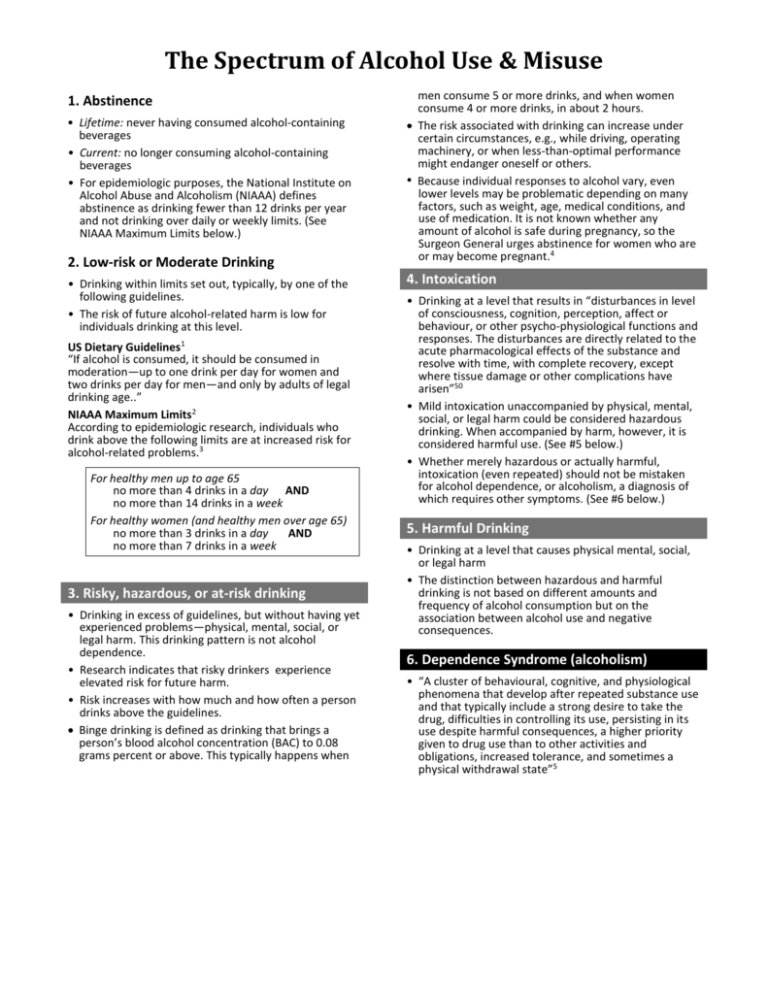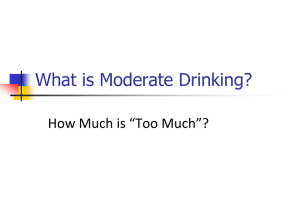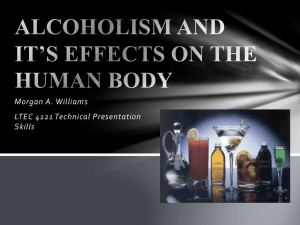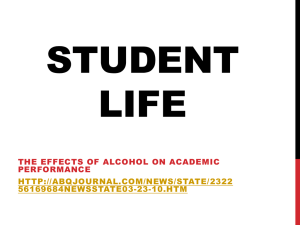Spectrum DOC
advertisement

The Spectrum of Alcohol Use & Misuse 1. Abstinence • Lifetime: never having consumed alcohol-containing beverages • Current: no longer consuming alcohol-containing beverages • For epidemiologic purposes, the National Institute on Alcohol Abuse and Alcoholism (NIAAA) defines abstinence as drinking fewer than 12 drinks per year and not drinking over daily or weekly limits. (See NIAAA Maximum Limits below.) 2. Low-risk or Moderate Drinking • Drinking within limits set out, typically, by one of the following guidelines. • The risk of future alcohol-related harm is low for individuals drinking at this level. US Dietary Guidelines1 “If alcohol is consumed, it should be consumed in moderation—up to one drink per day for women and two drinks per day for men—and only by adults of legal drinking age..” NIAAA Maximum Limits2 According to epidemiologic research, individuals who drink above the following limits are at increased risk for alcohol-related problems.3 For healthy men up to age 65 no more than 4 drinks in a day AND no more than 14 drinks in a week For healthy women (and healthy men over age 65) no more than 3 drinks in a day AND no more than 7 drinks in a week 3. Risky, hazardous, or at-risk drinking • Drinking in excess of guidelines, but without having yet experienced problems—physical, mental, social, or legal harm. This drinking pattern is not alcohol dependence. • Research indicates that risky drinkers experience elevated risk for future harm. • Risk increases with how much and how often a person drinks above the guidelines. Binge drinking is defined as drinking that brings a person’s blood alcohol concentration (BAC) to 0.08 grams percent or above. This typically happens when men consume 5 or more drinks, and when women consume 4 or more drinks, in about 2 hours. The risk associated with drinking can increase under certain circumstances, e.g., while driving, operating machinery, or when less-than-optimal performance might endanger oneself or others. • Because individual responses to alcohol vary, even lower levels may be problematic depending on many factors, such as weight, age, medical conditions, and use of medication. It is not known whether any amount of alcohol is safe during pregnancy, so the Surgeon General urges abstinence for women who are or may become pregnant.4 4. Intoxication • Drinking at a level that results in “disturbances in level of consciousness, cognition, perception, affect or behaviour, or other psycho-physiological functions and responses. The disturbances are directly related to the acute pharmacological effects of the substance and resolve with time, with complete recovery, except where tissue damage or other complications have arisen”50 • Mild intoxication unaccompanied by physical, mental, social, or legal harm could be considered hazardous drinking. When accompanied by harm, however, it is considered harmful use. (See #5 below.) • Whether merely hazardous or actually harmful, intoxication (even repeated) should not be mistaken for alcohol dependence, or alcoholism, a diagnosis of which requires other symptoms. (See #6 below.) 5. Harmful Drinking • Drinking at a level that causes physical mental, social, or legal harm • The distinction between hazardous and harmful drinking is not based on different amounts and frequency of alcohol consumption but on the association between alcohol use and negative consequences. 6. Dependence Syndrome (alcoholism) • “A cluster of behavioural, cognitive, and physiological phenomena that develop after repeated substance use and that typically include a strong desire to take the drug, difficulties in controlling its use, persisting in its use despite harmful consequences, a higher priority given to drug use than to other activities and obligations, increased tolerance, and sometimes a physical withdrawal state”5 The figure and text below are from an NIAAA guide.2 Many people don’t know what counts as a standard drink and so they don’t realize how many standard drinks are in the containers in which these drinks are often sold. Some examples: For beer, the approximate number of standard drinks in • 12 oz. = 1 • 16 oz. = 1.3 • 22 oz. = 2 • 40 oz. = 3.3 For malt liquor, the approximate number of standard drinks in • 12 oz. = 1.5 • 16 oz. = 2 For table wine, the approximate number of standard drinks in • a standard 750-mL (25-oz.) bottle = 5 For 80-proof spirits, or “hard liquor,” the approximate number of standard drinks in • a mixed drink = 1 or more* • a pint (16 oz.) = 11 • a fifth (25 oz.) = 17 • 1.75 L (59 oz.) = 39 • 22 oz. = 2.5 • 40 oz. = 4.5 *Note: It can be difficult to estimate the number of standard drinks in a single mixed drink made with hard liquor. Depending on factors such as the type of spirits and the recipe, a mixed drink can contain from one to three or more standard drinks. ) U.S. Department of Agriculture and U.S. Department of Health and Human Services. Dietary Guidelines for Americans, 2010. 7th Edition, Washington, DC: U.S. Government Printing Office, December 2010. Available at http://www.cnpp.usda.gov/Publications/DietaryGuidelines/2010/PolicyDoc/PolicyDoc.pdf 2) Helping Patients Who Drink Too Much; A Clinician’s Guide, Updated 2005 Edition, NIH Publication No. 05-3769, Reprinted May 2007. Available at http://pubs.niaaa.nih.gov/publications/Practitioner/ CliniciansGuide2005/clinicians_guide.htm 3) Dawson DA, Grant BF, Li TK. Quantifying the risks associated with exceeding recommended drinking limits. Alcohol Clin Exp Res. 29(5):902-908, 2005. 4) U.S. Surgeon General releases advisory on alcohol use in pregnancy [press release]. Washington, DC. U.S. Department of Health and Human Services. February 21, 2005. Available at: www.hhs.gov/ surgeongeneral/pressreleases/sg02222005.html 5) The ICD-10 Classification of Mental and Behavioural Disorders: Clinical Descriptions and Diagnostic Guidelines. Geneva, Switzerland: World Health Organization; 2010. 6) American Psychiatric Association. Diagnostic and Statistical Manual of Mental Disorders, Fourth Edition. Washington, DC: American Psychiatric Association, 2000. 2008, D Hungerford, J Higgins-Biddle, K Cates-Wessel






